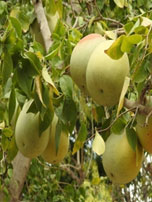SHAHEED KARTAR SINGH SARABHA AYURVEDIC MEDICAL COLLEGE & HOSPITAL
Affiliated to Guru Ravidas Ayurved University, Hoshiarpur Punjab
Affiliated to Guru Ravidas Ayurved University, Hoshiarpur Punjab

Botanical Name : Aegle marmelos (L.) Correa ex Roxb.
Family : Rutaceae
Introduction :
This plant have religious background in India & Nepal. Bilva is called Siva Druma (Lord Siva’s favorite tree) is held sacred by Hindus, the leaves being offered in prayers to Siva & Pãrvati.
Names in different Indian languages :
English : Bael tree, Bengal Quince
Hindi : Bel
Kannada : Bilapatre
Malayalam : Vilvam or kuvalam
Sanskrit : Bilva
Tamil : Vilvam or kuvalam
Telugu : Maredu
Unani : Bael
Synonyms :
Shriphala, Shaandilya, Shailuusha, Shalya, Sadaaphala, Mahaakapitha , Maaluura, Rudrajataa, Rudranirmaalya, Shivajataakhya
Classification according to Charaka, Susrutha & Vagbhata :
Charaka
Sothahara, Arsoghna, Asthãpanopaga
Susrutha
Varunãdi, Ambasthãdi, Brhat Pancamüla
Vagbhata
Varunãdi, Ambasthãdi, Brhat Pancamüla
Varieties & adulterants – (CV – controversy, AD – adulterants) :
No controversy about this plant.
Aduleteration: Bel fruit pulp is adulterated by adding kapitiha fruit pulp. Bel fruit pulp has cavities unlike kapittha.
Morphology :
It is a medium to fairly large sized deciduous and glabrous tree up to 6-8 high and 1-1.2 m in girth. Branches armed with straight sharp, axillary 2.5 cm long spines. Bark soft, corky, light grey.
Leaves alternate, trifoliate, occasionally digitately pentafoliate. Leaflets ovate or ovate lanceolate, crenate, acuminate, lateral sessile, terminal long petioled.
Flowers large, greenish white, sweet scented in short axillary panicles.
Fruits globose, grey or yellow, rind woody.
Seeds- numerous, oblong, compressed, em-bedded in sacs covered with thick orange coloured sweet pulp.
Distribution & Habitat :
found almost throughout India.
Chemical constituents :
xanthotoxol , alloimperatorin methyl ether, rutin and marmesin, alpha-fagarine,
Fruit pulp contains mucilage, pectin, sugar, tannin, volatile oil, gum. bitter principle and 2% ash, It contains an active principle known as marmelocin. Fresh leaves contain an essential oil- Seeds contain oil which is laxative. Roots, leaves and bark contain an astringent principle.
Root—xanthotoxin, umbelliferone, marmesin, marmin, skimmin etc.
Heart wood— furoquinoline, marmesin, beta—sitosterol etc. Leaves— essential oil , beta phellandrene, rutin, marmesinin, aegelin, aegelenine, etc.
Ripe fruits—xanthotoxol, marmesin, skimmin etc.
Unripe fruits—marmeline, aegeline, imperatorin, alloimperatorin and xanthotoxol etc.
Properties :
The properties of unripe and ripen fruit are tabulated:
Ripen fruit
Unripen Fruit
1. Sweet, aromatic, cooling, alterative, nutritive and laxative.
1.Astringent, digestive, stomachic little constipative (antidiarrhoeal) stimulant, antipyretic, antiscorbutic, bitter and pungent.
2. Acrid, bitter, sweet, appetizer, binding tonic, febrifuge, causes biliousness and removes vata & kapha, good for heart (Ref. From: Kirtikar & Basu)
2. Oily, bitter, acrid, sour, tasty but difficult to digest, appetizer, binding, cures dysentery, removes pain (Ref. From: kirtikar & Basu).
(Apakva phala)
Rasa Kasãya, Tikta
Guna Laghu, Ruksa
Virya Usna
Vipãka Katu
Karma : Vata-kapha hara, Grãhi, Dipana-Pacana
Indication :
Atisãra, Grahani, Prameha, , Agnimandya , Arsas
Part used :
Fruit, leaves, root
Mainly unripe fruit
Dosage :
Leaf juice 10-15 ml
Powder 2-4 g
Decoction 50-100 ml
External uses :
In conjunctivitis, leaf juice is put in the eyes and paste of leaves is applied over the eyelids, In disease conditions like swelling, pain in the ribs.
Main action : Roots are useful in vata disorders, fruit iv disorders of internal channel. Bel, durva and tulasi re used in vata, pitta and kapha disorders especially.
Internal uses :
Nervous system : root tranquilizes the nerves hence it is used in vata disorders, insomnia, epilepsy and hysteria.
Digestive system: Unripe fruit is an appetizer, digestant and astringent. Ripe fruit is astringent and a sweet, mild laxative. An excess dose causes constipation. It is very heavy 10 digest and vitiates doshas, gives bad odour to flat, is. Leal juice is live, stimulant. Root bark, unripe fruit are useful in loss of appetite. diarrhoea. dysentery, pain in abdomen. Unripe fruit ground to a paste and cooked with sugar is very beneficial in bleeding piles.
Circulatory system : It is a cardiac tonic, haemostatic and alleviates swelling, hence the root is used in cardiac debility and palpitations. Fruit has haemostatic property. Root bark and leaf juice are used to alleviate oedema.
Respiratory system: It is kaphashamak hence used in cold, cough. dyspnoea. Decoction of leaves is given for cold.
Urinary system: Juice of bel leaves helps in reducing blood sugar. Leaf juice is given in ikshumeha. Mixture of fresh fruit pulp and kankol is used in gonorrhoea. It alleviates swelling and pain. Mixture of bark juice and sweet cumin seeds is beneficial in shukrameha.
Reproductive system: Bilva root alleviates the inflammation of uterus, hence it is used in pregnancy. leucorrhoea and puerperal disorders.
Temperature : Bilva root and leaves are febrifuge. Decoction of roots is given in intermittent fever while leaf juice can be given in all types of fever.
Satmikaran : it is a bitter tonic. Its root and leaves have an anabolic effect on all body tissues. Since the ripe fruit is sweet to taste, it also acts as a tonic.
Important Yogas or Formations :
Vilwadi gutika, Dasamula kasaya, Dasamula grita,Bilvamooladi gutiks etc.
Therapeutic Uses :
(1) Pittãtisära— Fruit pulp of Bilva and Madhuka are mixed with sugar and honey and administered with rice-water (S.S.Ut.40).
(2) Grahani— Paste of unripen fruit of Bilva is given with sunthi and Guda while the patient is on butter milk as diet (V.M.).
(3) Kãmalã—Leaf juice of Bilva is given along with Triktu
(C.S.Ci.16)
